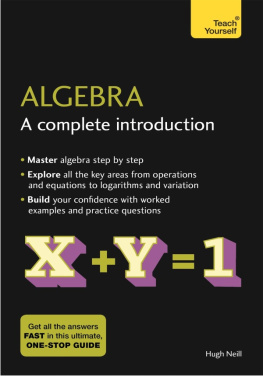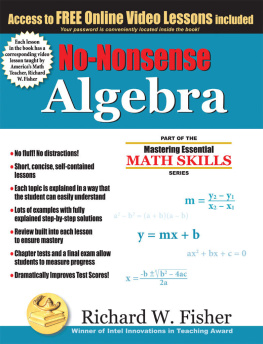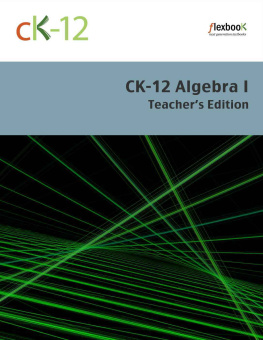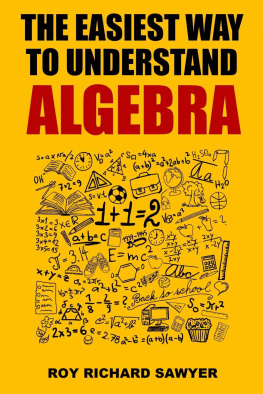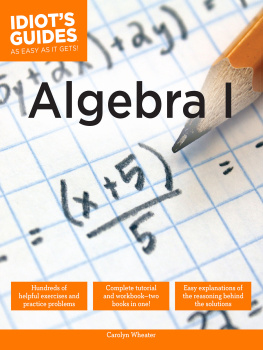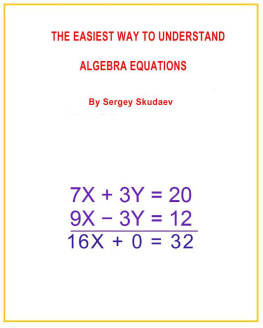ALGEBRA
A complete introduction
P. Abbott and Hugh Neill
Contents
Introduction
Algebra, like arithmetic, deals with numbers. The two subjects have much in common; indeed, algebra has been called 'generalized arithmetic', though this is a very incomplete description of it. It would perhaps be more correct to say that algebra is an extension of arithmetic.
Both subjects employ the fundamental operations of addition, subtraction, multiplication and division of numbers, subject to the same laws. In each, the same symbols, +, , , , , are used to indicate these operations, but in algebra, as new processes are developed, new symbols are invented to assist the operations. Terms such as fractions, ratio, proportion, square root, etc. have the same meaning in both subjects, and the same rules govern their use.
In arithmetic you use numbers whose values are known; you operate with these and obtain definite numerical results. In algebra, however, while you may use definite numbers on occasions, you are, in the main, concerned with general expressions and general results, in which letters or other symbols represent numbers not named or specified.
Algebra is an essential tool in mathematics and underpins most areas of mathematics and science. The ability to manipulate equations and formulae is a key part of trigonometry, calculus, mechanics and statistics. Physics and chemistry are obvious examples of subjects that use a great many formulae but other subjects such as economics or psychology also rely on algebra. For example, when psychologists test a hypothesis on a large group of subjects they need to use algebra to help interpret the results.
Algebra has many applications in everyday life: algebra enables you to input a formula into a spreadsheet, or work out the compound interest payable to you on your bank account. A toy manufacturing company might use algebra to work out the optimal number of a particular doll to produce given certain constraints of expected sales, limited running time and manufacturing costs: this is a process called linear programming. Architects need to solve complex equations when designing a new building, a statistician will use algebraic formulae when interpreting the results of the latest opinion poll and a pharmacist will use a formula to work out the correct dosage of a drug. When you buy a new carpet, you work out the area of the flooring to find the total cost. When you go on a long journey you might make a rough calculation to estimate your arrival time. All of these examples involve the use of algebra.
Often algebraic processes are used informally, but actually writing down and formalizing an approach to solving a problem is very powerful. For example, you can manually enter the numbers 10, 20, 30, 40, 50, , 1000 into column A of a spreadsheet or you can enter 10 into cell A1, '=A1+10' into cell A2 and then copy the formula down into the required number of cells. The end result is the same, but the second method is much more efficient. To work out the amount of money you will have in a savings account after 5 years at 5% interest, you could work out the amount after year 1, then year 2 and so on, or you can use the formula: final amount = initial investment 1.055.
Algebra is often used when solving brain training puzzles, albeit informally. These puzzles hone your logical thinking skills and are, studies suggest, good for preserving your mental health. Often puzzles are solved by using algebraic techniques. For example, a puzzle like: 'If 4 coffees and 3 cakes cost 11.70 and 2 coffees and 1 cake cost 5.10, how much is a cake?' can be reasoned out using the algebraic thinking. One line of reasoning would be: '2 coffees and 1 cake cost 5.10, so 4 coffees and 2 cakes would cost 10.20. But 4 coffees and 3 cakes cost 11.70 and the difference between the orders is 1 cake or 11.70 10.20 = 1.50. So a cake costs 1.50.' You would use exactly the same reasoning to solve simultaneous equations, but algebra allows you to generalize the method. Wrestling with a tricky algebra problem or concept is deeply satisfying once you have finally solved it there is a definite 'eureka!' moment.
The ability to think logically, reason clearly, to manipulate numbers and spot patterns is key to many careers, and a large number of employers will specifically ask for these attributes. Being confident with algebra is fundamental to these skills.
Algebra is such a wide and comprehensive subject that this book cannot be regarded as anything more than an elementary introduction to it. It will help you to learn something of the principles and foundations of the subject, thus enabling you to proceed to the study of more detailed and advanced books. It also provides the knowledge of algebra required for engineering, etc. Consequently some of those elementary sections of the subject which are of little use for these purposes have not been included.
The exercises are progressive and designed to enable you to test your knowledge of what you have studied and to provide material for your training in that power of manipulation which is so essential. They contain few of the more complicated or academic problems which are beyond the practical requirements of the ordinary student.
An appendix contains a very brief summary of the meaning of permutations and combinations, the binomial theorem, and the nature of the roots of a quadratic equation. Also included are those formulae which you may require when beginning work on the calculus or other branches of mathematics.
While the fundamental laws of algebra have not been entirely overlooked, rigid proofs of them have been omitted, owing to exigencies of space. It is hoped, however, that the logical basis of the subject has not been seriously impaired by the omissions.
Some emphasis has been placed on the graphical aspects of parts of the subject, since experience has shown that they prove stimulating and provide revealing help to the student.
No previous mathematical knowledge is required for this work, beyond that of arithmetic. References have occasionally been made to theorems in geometry or trigonometry for the benefit of those students who have some knowledge of them.
The author would like to thank mr Hugh Neill for his work on recent editions. This includes updating and modernizing the text. Thanks too to mr C.E. Kerridge for permission to use examples from National Certificate mathematics Vol I and mr H. marshall for the use of examples from Vol II.
The publishers would like to thank Sophie Goldie for her work on this edition of the book.
The meaning of algebra
In this chapter you will learn:
that in algebra letters stand for numbers
how to substitute numbers for letters
how to write down simple algebraic expressions.
1.1 An illustration from numbers
The following example illustrates the use of letters to represent generalizations in number. You know that
if any integer that is, a whole number is multiplied by 2, the result is always an even number
if any even number is increased by 1, the result is an odd number.
These two statements can be combined in one as follows.
If any integer is multiplied by 2 and the product increased by 1, the result is an odd number.


